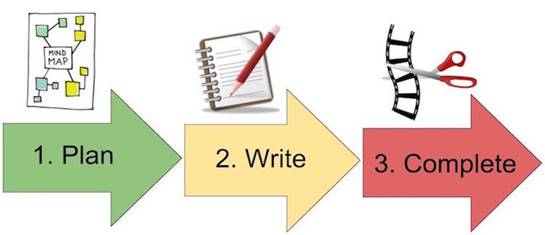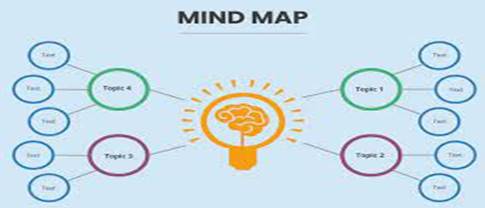
1. Writing a paragraph
1.1. The writing process
|
Ø Planning means you think like a writer; determine your purpose and audience; develop ideas about your topic; consider using an outline. Ø Drafting means you write a first pass by composing your ideas into sentences and paragraphs. Ø Revising means you rewrite your drafts often more than once, for the purpose of expanding or tightening them; rearranging or deleting parts; checking that you have stayed on your topic. Ø Editing means you check for the correctness including grammar, spelling, punctuation, and mechanics. Ø Proofreading means you carefully scrutinize your final draft to fix typing errors and missing words. |
Infographic

https://study.com/academy/lesson/practical-application-three-step-writing-process-infographic.html
Behind each writing project lies the purpose, for its being undertaken. Purposes for writing vary, and each makes its own demands on the writer. Here some typical purposes for writing:
ü To narrate something about your life or ideas that’s worth knowing
ü To give information
ü To analyze a text
ü To argue or persuade
*In favor of a point of view on a debatable issue
*In favor of a proposal or a solution to a problem
ü To evaluate the quality of a text, object, individual, or event
The audience for your writing can consist of different people. Imagining who your readers are increases chances for engaging their attention. Ways to imagine your audience:
ü Their level of knowledge
ü Their interests
ü Their beliefs
ü Their backgrounds
ü Relation to you
Brainstorming means listing everything that comes to mind about your topic. Let your mind room, and jot down all ideas that flow logically or that simply pop into your head. After you have brainstormed for a while, look over your list for patterns. If you don’t have enough to work with, choose one item in your list and brainstorm from there.
Mapping is a visual form of brainstorming. Write your topic in the middle and then circle it. Move out from the middle circle by drawing lines with circles at the end of each line. Put in each circle a subtopic related to the main topic.

https://www.google.com/url?sa=i&url=https%3A%2F%2Fwww.mindmapper.com%2Fbenefits-of-mind
EXERCISE 1
Here is a list of brainstormed items. Organize them in a mind map. The topic is “Ways to promote a new movie”.
Previews in theaters suspense director
TV ads book the movie was based on topical subject
Provocative locations special effects
Movie reviews internet trailers dialogue
How movie was made adventure excitement
Sneak previews newspaper ads photography
Word of mouth stars Facebook page
1.2. Outlining
An outline is a structured, sequential list of the contents of a text. An informal outline does not follow the numbering and lettering conventions of a formal outline. It often looks like a brainstorming list, with ideas jotted down in a somewhat random order.
A formal outline follows long – established conventions for using numbers and letters to show relationships among ideas. To compose a formal outline, always use at least two subdivisions at each level – no I without a II, no A without a B. If a level has only one subdivision, either integrate it into the higher level or expand it into two subdivisions.
Thesis statement/topic sentence
I. First main idea
A. First subordinate idea
1. First reason or example
2. Second reason or example
a. First supporting detail
b. Second supporting detail
B. Second subordinate idea
II. Second main idea
1.3. Paragraph
A paragraph is a group of sentence that work together to develop a unit of thoughts. Paragraphs help you divide material into manageable parts and arrange the parts in a unified whole. Academic writing typically consists of an introductory paragraph, a group of body paragraphs, and a concluding paragraph.
Introductory paragraphs point to what lies ahead and seek to arouse readers’ interest.
ü Provide relevant background information about your topic.
ü Relate a brief.
ü Give pertinent, perhaps surprising statistics about your topic.
ü Ask a provocative question to lead into your topic.
ü Use a quotation that relates closely to your topic.
ü Draw an analogy to clarify or illustrate your topic.
ü Define a key term you use throughout your piece of writing.
A topic sentence contains the main idea of a body paragraph and controls its content. Topic sentences are usually generalizations containing the main idea of the paragraph. The connection between the main idea and its supporting details in the sentences that follow it needs to be clear. Topic sentences usually come at the beginning of a paragraph, but putting them at the end or implying them can be effective in some cases. When a topic sentence starts a paragraph, readers immediately know what topic will be discussed. When a topic sentence ends a body paragraph, all sentences leading to it need to flow into it clearly. Some paragraphs convey a main idea without a specific topic sentence. This technique requires special care so that the details clearly add up to a main idea.
EXERCISE 2
Working individually or with a group, identify the topic sentences in the following paragraphs. If the topic sentence is implied, write the point the paragraph conveys.
https://www.jscc.edu/academics/programs/writing-center/writing-resources/five-paragraph- essay.html
Body paragraphs in an essay come after the introductory paragraph. The sentences support the generalization in the topic sentence. If you need help in thinking of details, try using RENNS.
R = Reasons can provide support.
E = Examples can provide support.
N = Names can provide support.
N = Numbers can provide support.
S = Senses – sight, sound, smell, taste, touch – provide support.
The concluding paragraph of an essay needs to follow logically from your thesis statement and body paragraphs. Never merely tack on a conclusion. Your concluding paragraph provides a sense of completion, a finishing touch that enhances the whole essay.
1.4. Paragraph coherence
A paragraph has coherence when its sentences are connected in content and relate to each other in form and language. Coherence creates a smooth flow of thoughts within each paragraph as well as from one paragraph to another. Transitional words and expressions, deliberate repetition, and parallelism can help make your writing coherent.
Transitional expressions are words and phrases that express connections among ideas, both within and between paragraphs. Here are some tips for using transitions effectively.
ü Vary the transitional expressions that you use within a category.
ü Use each transitional expression precisely, according to its exact meaning.
|
ADDITION – also, besides, equally important, furthermore, in addition, moreover, too
COMPARISON – in the same way, likewise, similarly
CONCESSION – granted, naturally, of course
CONTRAST – at the same time, certainly, despite the fact that, however, in contrast, instead, nevertheless, on the contrary, on the other hand, otherwise, still
EMPHASIS – indeed, in fact, of course
EXAMPLE – a case in point, as an illustration, for example, for instance, namely, specifically
PLACE – here, in the background, in the front, nearby, there
RESULT – accordingly, as a result, consequently, hence, then, therefore, thus
SUMMARY – finally, in conclusion, in short, in summary
TIME SEQUENCE – eventually, finally, meanwhile, next, now, once, then, today, tomorrow, subsequently, yesterday |
ИСПОЛЬЗОВАННАЯ ЛИТЕРАТУРА
1. Academic writing from paragraph to essay. Dorothy E Zemach, Lisa A Rumisek. Macmillan , 2015
2. Quick access, reference for writers, 7th edition. Lynn Q. Troyka, Douglas Hesse. Pearson, 2013
Скачано с www.znanio.ru
Материалы на данной страницы взяты из открытых источников либо размещены пользователем в соответствии с договором-офертой сайта. Вы можете сообщить о нарушении.